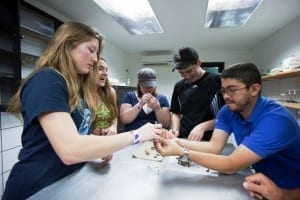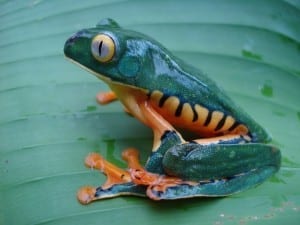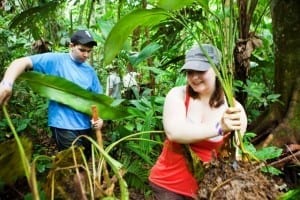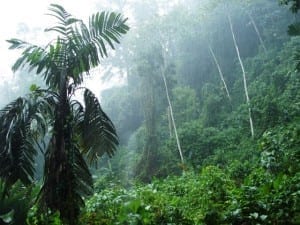Tripatini
the world's smartest travel social network
Costa Rica's Biodiversity Stars in Educational Research Programs at Veragua Rainforest
Summer school breaks are coming up for North America and Europe, and with that the opportunity for student groups to enjoy educational trips. The Neotropical rainforest of Costa Rica in Central America, part of one of the most important reserves of biodiversity on Earth, is fertile ground for study disciplines such as Ecology, Biology, Environmental Sciences, Animal Behavior, Zoology, Ornithology, Herpetology, Geography, Plant Sciences, and Land Economy, among others.
 The study and sustainable preservation of biodiversity is vital to an enduring existence for humans and all life on the planet, according to Dr. Mike Rands, Executive Director of the University of Cambridge Conservation Initiative in England.
The study and sustainable preservation of biodiversity is vital to an enduring existence for humans and all life on the planet, according to Dr. Mike Rands, Executive Director of the University of Cambridge Conservation Initiative in England.
“Life on Earth is at risk from an unprecedented rate of environmental change that threatens the natural resources on which humanity depends. Biodiversity – the genes, species and ecosystems that comprise nature – provides food, fuel, medicines and other vital ‘ecosystem services’, along with countless intangible benefits, for society. But biodiversity is in steep decline, and its sustainable management is a major challenge for the 21st century,” explains Rands.
The Neotropics include more tropical rainforest than any other eco-zone, extending from southern Mexico through Central America and northern South America to southern Brazil, including the vast Amazon Rainforest (reference: Wikipedia). Veragua Rainforest Research & Adventure protects 1,300 hectares (3,212 acres) of tropical rainforest in the foothills of the Talamanca Mountain Range in Costa Rica, an hour inland from the Caribbean Coast and the port town of Limón. The biology research center and adventure destination borders the La Amistad (“Friendship”) International Park, which is the country’s largest and most remote national park shared by both Costa Rica and Panama.
Veragua’s team of biologists work in partnership with the University of Costa Rica (UCR), Costa Rica’s National Institute of Biodiversity (INBio), and the National Museum of Natural History to preserve the area’s population of frogs, snakes, lizards, iguanas, insects, butterflies and birds.
 Veragua Rainforest offers an excellent educational opportunity for students and educators with hands-on research of rainforest life. The property contains a biology research station, wildlife habitats, walking trails through the rainforest, a river and waterfall, an aerial tramway, a canopy zip line tour, group accommodations, and a restaurant, café and souvenir shop. Ongoing research at Veragua is coordinated by University of Costa Rica biologists José Andrés Salazar and Rolando Ramírez. Salazar is a Herpetologist, and Ramirez specializes in Entomology.
Veragua Rainforest offers an excellent educational opportunity for students and educators with hands-on research of rainforest life. The property contains a biology research station, wildlife habitats, walking trails through the rainforest, a river and waterfall, an aerial tramway, a canopy zip line tour, group accommodations, and a restaurant, café and souvenir shop. Ongoing research at Veragua is coordinated by University of Costa Rica biologists José Andrés Salazar and Rolando Ramírez. Salazar is a Herpetologist, and Ramirez specializes in Entomology.
Some examples of educational programs possible at Veragua Rainforest:
- Veragua’s Snakes, Frogs, Toads and Butterflies: Veragua Rainforest has at
 present identified 55 species of frogs, the greatest diversity in Costa Rica, according to Salazar. To help sustain the frogs and other species, Veragua has created artificial habitats with all natural elements so the animals can thrive and reproduce. Using natural plants, earth and water, it’s as if they’ve taken a real section of the forest and put a bubble over it. Salazar and his team even created the planet’s largest nocturnal frog exhibit. Students will work with resident biologists to learn relevant and interesting information (regions found, maximum size, eating habits, etc.) about the various species in the exhibits. Then they will go out into the rainforest to encounter animals in the wild, and to look for new species.
present identified 55 species of frogs, the greatest diversity in Costa Rica, according to Salazar. To help sustain the frogs and other species, Veragua has created artificial habitats with all natural elements so the animals can thrive and reproduce. Using natural plants, earth and water, it’s as if they’ve taken a real section of the forest and put a bubble over it. Salazar and his team even created the planet’s largest nocturnal frog exhibit. Students will work with resident biologists to learn relevant and interesting information (regions found, maximum size, eating habits, etc.) about the various species in the exhibits. Then they will go out into the rainforest to encounter animals in the wild, and to look for new species.
- Butterfly and Beetle Trap Set-up: With Veragua’s on-site biologist, students will go out into the field to set up insect and butterfly traps for future collection and identification.
 Butterfly Garden Work: Students will work on activities such as garden maintenance, collecting eggs and wings, pupa box maintenance, pupa selection, releasing butterflies, butterfly garden feeding, and seed planting in the garden.
Butterfly Garden Work: Students will work on activities such as garden maintenance, collecting eggs and wings, pupa box maintenance, pupa selection, releasing butterflies, butterfly garden feeding, and seed planting in the garden.
- Owl and Insect Night Hike: Students get the chance to experience the rich sounds and unusual visuals of the rainforest at dark by going out onto the trails with Veragua’s biologists. Students will discover nocturnal frogs, colorful insects, snakes, and possibly even nocturnal mammals such as the opossum or the kinkajou. Another fun activity for students is to identify the different characteristics of nocturnal insects and moths with the on-site entomologist.
 Peje School Community Work: Located 2 miles from the Veragua Rainforest entrance, the Peje School is the community’s local elementary school. Students will interact with the school children on such activities as maintenance projects, English tutoring, tree planting and singing local songs with them.
Peje School Community Work: Located 2 miles from the Veragua Rainforest entrance, the Peje School is the community’s local elementary school. Students will interact with the school children on such activities as maintenance projects, English tutoring, tree planting and singing local songs with them.
Veragua Rainforest Research & Adventure offers educational program packages from 2 to 4 days, or longer. Accommodations are dorm-style with bunk beds sleeping 8 persons per room (6 dorm rooms); there is one double room with twin beds and private bathroom for teachers. Men and women have separate shared bathrooms with showers.
Veragua Rainforest Research & Adventure Park is an all-in-one total rainforest experience and not-to-be-missed when visiting Costa Rica’s Caribbean area. Veragua Rainforest Research & Adventure is open to day visitors Tuesday to Sunday, from 8:00 am to 3:00 pm. Admission is $66 for adults and $55 for children/students; children under age 4 receive free admission. Veragua is located 40 minutes from Limon and 2 ½ hours from San José, in Brisas de Veragua, 12 km south from the Liverpool entrance on the highway to Limón.
By Shannon Farley
Videos
Groups
-
India
173 members
-
Tour Operators
873 members
-
Ireland
93 members
-
South Dakota
17 members
-
Azerbaijan
17 members
-
Shopping the World
55 members
-
Tech for Travel/Hospital…
87 members
-
Andorra
26 members
-
Online Corner
75 members
-
Minnesota
22 members
-
Backpackers & Hostels
84 members
-
Portugal
60 members
-
Turks and Caicos
26 members
-
Agritourism/Farmstays
72 members
-
Zambia
21 members
© 2025 Created by EnLinea Media.
Powered by
![]()
Badges | Report an Issue | Privacy Policy | Terms of Service


You need to be a member of Tripatini to add comments!
Join Tripatini